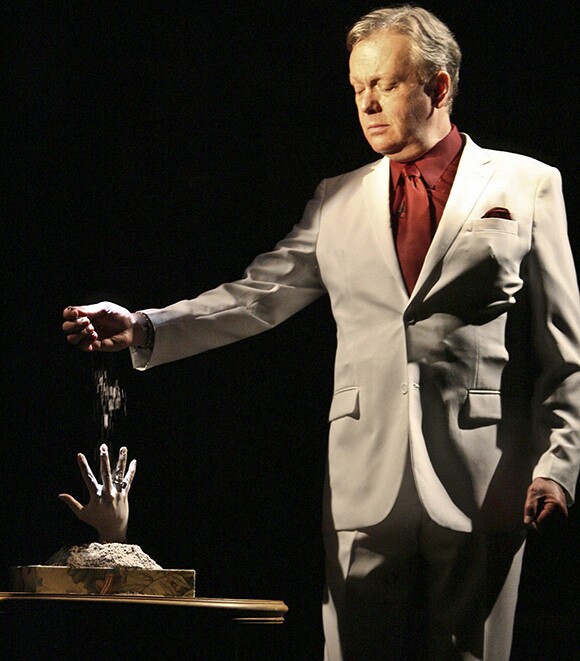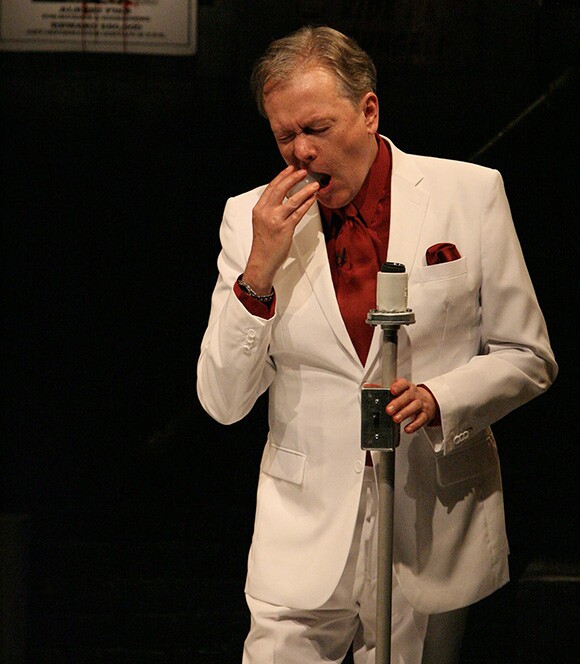Todd Robbins: Playing Dead with a Sideshow Artist

Dressed in a pimp-white suit and sporting a nefarious smile, Todd Robbins wants to scare the hell out of you. As for his suit, it won't be white for long. Soon it will be covered in blood.
It's all part of "Play Dead," an homage to scream-in-the-dark, clutch-your-date spook shows currently running at the Geffen Playhouse through December 22. Co-written by sideshow artist Robbins (who also stars), and Teller (of Penn and Teller illusionist fame), the play is a 75-minute interactive romp that ups the ante on cheesy fright-fests of yore.
And while Teller, the Harpo Marx of magicians who directs this orgy of terror and may be the more recognizable name in this production, Robbins certainly knows his way around a séance, a cemetery, and...the alimentary canal: In other words, the dude, himself a magician as well as an American Conservatory Theater-trained thespian, actually eats light bulbs during the show, as in, he chews up and swallows those wonderful creations that Edison, the Wizard of Menlo Park, gave to the world in 1879.
When asked what wattage, Robbins, who was born in Long Beach in 1955, quips during a pre-show break at the theater, "I usually eat a 100-watt bulb, but I'm on a diet, so it's 60-watts."
The question remains: Does he have a good gastroenterologist?
"He died," Robbins cracks, "it's sad. Really. Years ago I did a show and they wrote a piece on me in The New Yorker. They brought the head of gastroenterology from N.Y.U. Hospital to interview me, and the writer thought it was going to be a trick and he was going to bust me. It would be a big exposé, and the doctor was listening to everything I said, and I revealed everything I do, and he said, 'What you're doing to protect yourself is sound. I should recommend this to some of my patients.'
"I asked him, 'Where should I send the bill for consultation, doc?'"

Robbins, who has ingested some 5,000 light bulbs over the course of his career, including in his 2003, Drama Desk-nominated Off Broadway show, "Carnival Knowledge," was later asked to be a keynote speaker at a national gastroenterology conference. Happily, these ancillary talks have not detracted from him making good use of his other "carny" talents -- hammering a nail into his nose, sword-swallowing and the like -- skills he's been honing since he was a kid growing up in Long Beach. It was there, in what Robbins calls a "clean, suburban, quiet" town, that he was first drawn to a magic shop.
"The guys used to hang out there Saturday afternoons, swapping lies and doing card tricks, chain smoking Camel cigarettes," recalls Robbins, son of a soap executive and schoolteacher, "and I met some carny people there -- folks that did mediumship, séances, that type of thing. I found it intriguing.
"It wasn't admirable, but it was fascinating," continued Robbins, "and it was so different from everything else I was surrounded by that I kind of gravitated towards it to find out more. One afternoon one guy said, 'I give people hope. It's false hope, but it's hope, nevertheless.'"
At this point, 65-year old Teller, née Raymond Joseph Teller, who is sitting nearby, laughs. He will speak soon enough -- and eloquently: The quiet one has a distinctive literary voice and has written for, among other publications, The Atlantic Monthly, The New York Times and Esquire. He's also penned five books, three with Penn (Jillette) and two on his own. For now, though, he listens intently to Robbins, his face a study in neo-glee.

"We began 'Play Dead,' at Teller's home in Vegas," explains Robbins, "with a blank page. We took everything I did, put it aside, everything Teller had done with Penn - a number of séance pieces through the years -- and our whole background of genres and dark entertainment, and we started playing around with images. We began to see an arc come forth, and with help of [magic designer] Johnny Thompson, we came up with new tricks."
Those tricks led to a workshop at the Rio All-Suite Hotel and Casino, before they embarked upon a one-hour version of the show at another Vegas hotel, the Clarion.
Teller, dressed casually in jeans and sweatshirt, wearing tinted glasses, finally speaks: "It was Debbie Reynolds' old screening room, which is lined with gray velvet. Like a coffin."
More laughter.

And more talk from Teller, who not only performs an astonishing 46 weeks a year with Penn at the Rio, where the duo is the longest-running headline act in that town, but has also directed other theater pieces, including co-helming (with Aaron Posner) a 2008 version of Shakespeare's "Macbeth," conceived as a supernatural horror thriller and mounted at Two River Theater Company in Red Bank, New Jersey.
Says Teller: "We originally thought that within the tradition of spook shows that there would be one big dark section at the end. Several times during the show you're plunged into darkness and you either see luminous things that are coming at you in 3D or you feel things. Originally we thought that all of that would happen at the end.
"But then, when we worked with it, we came up with one very interesting other idea...to kill an audience member."
Of course, why not.

"Play Dead," which ran off-Broadway in 2010 and was also nominated for a Drama Desk award, had the New York Times' proclaim, "This wild, wicked show is not just a scream-fest after all; it's a pretty good piece of theater."
This killing, said Teller, would be justified by conducting a séance to bring back the dead audience member's spirit.
"We thought that'll be the punch line to the whole show, but as it turns out," adds Teller, "if you take an audience member away from their companion in a theater and then they don't come back for 45 minutes, they'd feel like they've missed out on the whole show.

"So we ended up realizing a good way to do this was to end the first half with the resurrection of that person, and make the second half even darker, more about the creepy things that people do to each other."
And those creepy, awful things that people do to each other is, according to this duo of deviltry, conducting séances.
Robbins should know. His interest in magic and carnivals brought him to the mother lode of creep-show/fundom, Coney Island, where he held positions, including sideshow performer and executive director. The tall actor with the mellifluous baritone voice has also been featured on more than 100 television shows, including multiple appearances on Letterman, Leno and Conan O'Brian, as well as being the main subject of the 2005 documentary "American Carny: True Tales From the Circus Sideshow."
In addition, Robbins is the author of "The Modern Con Man: How to Get Something for Nothing." These credentials, if nothing else, would seem to make Robbins the ideal go-to maestro of séances.
"We're talking about talking to the dead and using people's loss for personal profit, that's really the scariest of all," proclaims Robbins.

Teller, who directed a feature documentary, "Tim's Vermeer" (not about magic but about the Dutch painter), scheduled for release in early 2014, raises his voice a notch...or two, clearly outraged: "How do you get more evil than making up crap and selling it back to mourners and exploiting their grief when people are at their most vulnerable?
"At the beginning of our show, Todd promises to take you down into the darkest and most evil of places, and that's the darkest evil place we take you down. Killing off an audience member and resurrecting him in the form of luminous vapors? Why, that's just fun! To take you all the way down is what the second act does."
Robbins points out that "Play Dead" is "the most honest show you're ever going to see." He explains that the tricks are embedded in the show's DNA -- they're intrinsic to it.
Indeed, every story Robbins tells on stage is true. These tales include yarns about Albert Fish, the serial killer who eats children; he also regales with the story of Mina Crandon, a Massachusetts medium who supposedly had her own theory of wearing clothes -- or not. Then there's the tale of octogenarian Dorothy R. Bembridge, who was murdered and whom Robbins knew personally.
"There's nothing more horrifying than the truth," declares Robbins, whose teenage idea of fun was paying midnight visits to an unlocked cemetery in Long Beach, where he would proceed to concoct stories about the dead buried there. "In this play, the people are all real, the details are all true. So it's very honest that way.

"The people we bring up on stage do remarkable things -- there are no plants, no stooges. Nothing is pre-arranged," Robbins adds in a most convivial manner.
Teller, soft-spoken and choosing his words carefully, pipes up again: "Which you will not believe when you see the show -- what Todd is able to get people to do and what he does to them. It's very powerful. The other thing that Todd does much better is the readings about your relatives the way [TV/radio mediums] John Edward and Sylvia Brown do. Todd immediately says, 'It's just a trick.'"
"The Geffen," adds Teller, "is a very safe place. When you walk through the door into the theater we have to gradually convince you that you're walking into a place that's no longer quite so safe."
Some of that, Teller says, is because of Tom Buderwitz' set design. He and Robbins collaborated on the idea of making the set look like pieces from a carnival crime show as well as the old-school carnival ride, "Laff in the Dark."
"Okay, there is an electric chair in the corner," admits Teller. "And the 'Laff in the Dark' sign is illuminated and there are devils' heads on the little carts you would go on in this ride."

Straight-faced, the diminutive Teller adds: "It looks as if Todd, perhaps, was driving around in his tractor trailer, and saw these things and scooped them up and just put them there."
The duo also suggests theater-goers arrive early in order to hear the pre-show soundtrack (designed by Cricket S. Myers), a collage of carny images, dark images and carny talkers, many of whom are...no surprise, Robbins.
"We play with taking people from being theater-goers and the passive experience of sitting and watching a play and enjoying it," explains Robbins, "to being real participants in the show. A handful of people I drag up on stage and involve them directly. But everyone in the audience is part of this experience.
"We try to make it as fun, but we also try to do what we can to get under the skin of people. This white suit that I'm wearing will not end up pristine by the end of the show. After all," adds Robbins, an ominous note in his voice, "it's not a party until someone gets killed."
Dig this story? Sign up for our newsletter to get unique arts & culture stories and videos from across Southern California in your inbox. Also, follow Artbound on Facebook and Twitter.